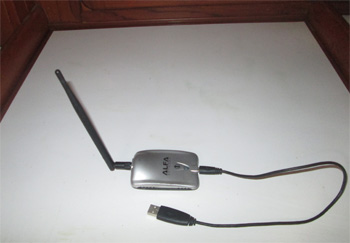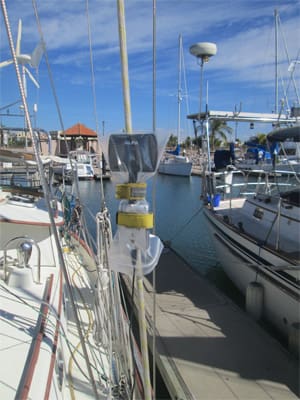Good Internet access has been very important to us over the years we have been crossing oceans. We get a lot of useful weather information via the Internet and also shop for new gear and search for opinions of people who have experience with something we are considering buying. When we are headed back to the states we always have a flurry of online ordering so that the items we want to bring back will be waiting for us when we get to our state-side destination.
Of course, e-mail has been very important to us for keeping in touch with friends and family and a good Internet connection is important to keeping our blog current and for posting photos.
We have never had Internet connections while at sea. Theoretically it is possible to have a very slow connection via our Iridium phone, but such a connection would cost more than we are willing to pay. We use the satphone and SSB with Winlink for our communications at sea.
Most of our cruising time is spent within reach of shore-side Internet connections of one sort or another.
 |
|
An ALFA WiFi adapter can be used in the boat when strong signals are available. |
We have used a large variety of wireless Internet connection devices over the years we have been on our circumnavigation. These devices fall into two groups of WiFi adapters and modems. The WiFi adapters are used to connect to wireless routers in marinas, restaurants and occasionally the signal of random routers that we are able to pick up. The other type of device we use is a modem that connects to the Internet through the cell phone system.
WiFi adapters
Most of the WiFi adapters we have used are made by ALFA Network and were purchased on Amazon.com. Ironically the very first model we purchased (model AWUS036H) has been the winner in terms of stability of the connections achieved and the distances, from the wireless router, over which the adapter will work. We paid about $35 for this adapter. We use these WiFi adapters with omni-directional (rubber ducky) antennas when at anchor and with a directional (high gain) antenna when we are in a marina and the boat is not swinging around. We only use the directional antennas when we must because a stiff breeze can cause the adapter/antenna combination to move around enough to cause an intermittent connection.
Over the years ALFA has brought out a variety of other adapters that offered features like higher transmit power and suitable for use outside. We enthusiastically bought the newest version when we were going to be back in the states. None of the fancier models have performed as well as the model listed above.
Since the AWUS036H is not weather proof we usually put it in a heavy duty zip-close bag with the wire coming out of the bottom. We use West Marine Velcro wraps to secure the adapter to a halyard and to provide strain relief on the cable below the zip-close bag. If we need to attach an extension cable, we use the amplified type and put any outdoor connections in another zip-close bag with both wires entering the bag from below. We make sure we have drip loops so no rainwater ever finds its way back into the bag.
On occasion we have used Chinese fry baskets as parabolic reflectors to boost the signal and reject noise from behind the antenna. This idea was developed by a student in Wellington, New Zealand, who was in a dorm room that was a significant distance from the university’s router. Google “WokFi” for information describing designs for what are sometimes called “WiFi signal strainers.”
We have attached the WiFi adapters inside the parabolic dish of the Chinese fry baskets or a wok using a variety of wire ties, pieces of old flip flops and Velcro wraps. It is much harder to make a WokFi system waterproof and the windage is quite a bit greater than the adapter in a bag approach. Most of the time we have not had to resort to using WokFi technology to get adequate signals.
We did buy one “marine” WiFi adapter that worked for a short time before its poor design resulted in water intrusion and corrosion damage. When it was working it was not nearly as good as our original ALFA adapter in a side-by-side comparison. It cost us close to 10 times as much as an ALFA adapter.
The other type of wireless Internet device we have used is a WiFi modem that is sold as either a USB stick or, the best, as a device that up to five computers can connect to via their internal WiFi adapters.
Some of these modems are unlocked so all you need is a new SIM card when you travel from country to country, but we have found that we could not usually get 3G speeds with an unlocked modem from a different cell service provider. We could achieve adequate connections, but when we were going to be anywhere for a significant amount of time we would usually break down and buy a modem to get the higher speeds especially if we were sharing the signal between two computers.
Recharge via USB port
The hands-down best device of this kind was the one we purchased from Telstra in Australia. It was about half the size of a pack of cigarettes and powered by an internal battery that could be recharged off a USB port. It could support up to five WiFi devices (computers, iPads, smartphones) and would run for five hours on a charge. The big advantage of this wireless connection to the computer is that it is possible to put the modem in a sealed zip-close bag and run it up to the masthead on a halyard. We were able to enjoy strong Internet connections when anchored 20 to 30 miles from shore on the Great Barrier Reef.
This modem also includes a slot for a memory chip so computers on board could share files without using e-mail which would eat into our monthly Internet allotment.
The modem also had a connection for an external antenna. We never bought the external antenna but heard good reports about it.
Another useful “tool” in our Internet access toolbox is a built-in feature of Windows operating systems after XP called WiFi sharing. Using this feature we could connect to a WiFi router and share the connection with another computer on board. The computer on the receiving end of this sharing arrangement could be an XP computer, but the computer doing the sharing had to have an operating system released more recently than XP.
It is also possible to share an Internet connection using an Ethernet cable between computers.
This was frequently economical when a marina would sell us access with a single user name and password. We know cruisers who have set up WiFi networks on their boats and have a bridge that lets a single WiFi connection service the devices on the boat, but we never felt the need for that sort of high-tech solution.

